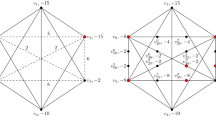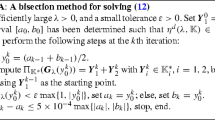Abstract
In this paper, an augmented Lagrangian method is proposed for binary quadratic programming (BQP) problems based on a class of continuous functions. The binary constraints are converted into a class of continuous functions. The approach reformulates the BQP problem as an equivalent augmented Lagrangian function, and then seeks its minimizer via an augmented Lagrangian method, in which the subproblem is solved by Barzilai–Borwein type method. Numerical results are reported for max-cut problem. The results indicate that the augmented Lagrangian approach is promising for large scale binary quadratic programming by the quality of the near optimal values and the low computational time.


Similar content being viewed by others
References
Helmberg, C.: Semidefinite Programming for Combinatorial Optimization. Konrad-Zuse-Zentrum fur informationstechnik, Berlin (2000)
Goeman, M.X., Williamson, D.P.: Improved approximation algorithms for maximum cut and satisfiably problem using semidefinite programming. J. ACM 42, 1115–1145 (1995)
Barahon, F., Grotschel, M.: An application of combinatorial optimization to statiscal optimization and circuit layout design. Oper. Res. 36, 493–513 (1998)
Peng, H.T., Rasmussen, L.K.: The application of semidefinite programming for detection in CDMA. IEEE Select. Commun. 19, 1442–1449 (2001)
Hasegawa, F., Luo, J., Pattipati, K., Willett, P.: Speed and accuracy comparation of techniques to solve a binary programming problem with application to syschronous CDMA. IEEE Trans. Commun. 52, 2775–2780 (2004)
Keuchel, J., Schnorr, C., Schellewald, C., Cremers, D.: Binary partitioning, perceptual grouping, and restoration with semidefinite programming. IEEE Trans. Pattern Anal. Mach. Intell. 25, 1364–1379 (2003)
Olsson, C., Eriksson, A.P., Kahl, F.: Improved spectral relaxation methods for binary quadratic optimization problems. Comput. Vis. Image Understand. 112, 3–13 (2008)
Wu, S.P., Boyd, S.: FIR filter design via semidefinite programming and spectral factorization. In: Proc. 35th Conf. Decision and Control, Kobe, pp. 271–276 (1996)
Peinadoo, M., Homer, S.: Design and performance of parallel and distributed approximation algorithms for max-cut. J. Parallel Distrib. Comput. 9, 141–160 (1998)
Burer, S., Monteriro, R.D.C.: A projected gradient algorithm for solving the max-cut relaxation. Optim. Methods Softw. 15, 175–200 (2001)
Burer, S., Monteriro, R.D.C., Zhang, Y.: Rank-two relaxation heuristics for MAX-CUT and other binary quadratic programs. SIAM J. Optim. 12, 503–521 (2001)
Liu, H., Wang, X., Liu, S.: Feasible direction algorithm for solving SDP relaxation of the quadratic \(\{-1,1\}\) programming. Optim. Methods Softw. 19, 125–136 (2004)
Murray, W., Ng, K.M.: An algorithm for nonlinear optimization problems with binary variables. Comput. Optim. Appl. 47, 257–288 (2010)
Pardalos, P.M.: Continuous approaches to discrete optimization problems. In: Di, G., Giannesi, F. (eds.) Nonlinear Optimization and Applications, pp. 313–328. Plenum, New York (1996)
Polijak, S., Wolkowicz, H.: Convex relaxation of (0,1)-quadratic programming. Math. Oper. Res. 3, 550–561 (1995)
Pan, S.H., Tan, T., Jiang, Y.: A global continuation algorithm for solving binary quadratic programming problems. Comput. Optim. Appl. 41, 349–362 (2008)
Chen, J.S., Li, J.F., Wu, J.: A continuation approach for solving binary quadratic program based on a class of NCP-functions. Appl. Math. Comput. 219, 3975–3992 (2012)
Liu, W.L.: Studies on algorithms for some problems in the field of communication signal processing. Doctor Dissertation, Department of Mathematics of Dalian University of Technology (2004)
Todd, M.J.: Semidefinite optimization. Acta Numer. 10, 515–560 (2001)
Alizadeh, F., Haeberly, J.P., Overton, M.L.: Primal-dual interior point methods for semidefinite programming: convergence rates, stability, and numerical results. SIAM J. Optim. 8, 746–768 (1998)
Barzilai, J., Borwein, J.M.: Two point step size gradient methods. IMA J. Numer. Anal. 8, 141–148 (1988)
Bertsekas, D.P.: Constrained Optimization and Lagrange Multiplier Methods. Academic Press, New York (1982)
Rinaldi, G.: Rudy graph generator (1998). http://www-user.tu-chemnitz.de/~helmberg/rudy.tar.gz. Accessed 12 Jan 2014
Helmberg, C., Rendle, F.: A spectral bundle method for semidefinite programming. SIAM J. Optim. 10, 673–695 (2000)
Alperin, H., Nowak, I.: Lagrangian smoothing heuristics for max-cut. J. Heurist. 11, 447–463 (2005)
Choi, C., Ye, Y.: Solving sparse semidefinite programs using the dual scaling algorithm with an iterative solver. Working paper, Department of Management Science, University of Iowa, IA (2000)
Author information
Authors and Affiliations
Corresponding author
Additional information
The work is supported by National Science Foundation for Young Scientists of China (No. 11101320), by the National Natural Science Foundation of China (No. 11032008, 11372069), and by China Scholarship Council (CSC). This work was conducted while the first author has been visiting Ohio University, Department of Mathematics.
Rights and permissions
About this article
Cite this article
Mu, X., Liu, W. An augmented Lagrangian method for binary quadratic programming based on a class of continuous functions. Optim Lett 10, 485–497 (2016). https://doi.org/10.1007/s11590-015-0873-8
Received:
Accepted:
Published:
Issue Date:
DOI: https://doi.org/10.1007/s11590-015-0873-8




